- Posted on November 11th, 2024
Global Grooves – Powering Carnival Arts with Hydro Energy and Community Engagement
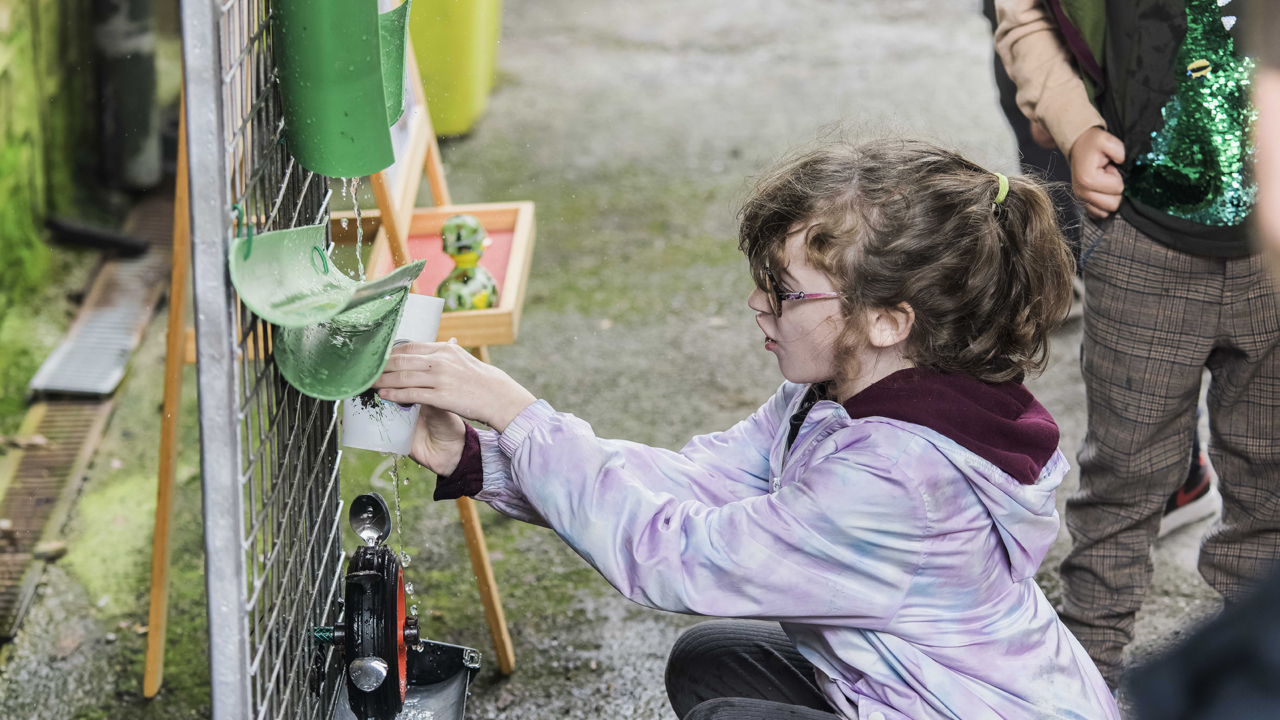
For Arts Council England and Julie’s Bicycle’s annual report 2023-24, we feature over 50 practical examples of cultural organisations taking climate action including 9 other in depth case studies like this one. Check out the full interactive report here.
This case study was written by Global Grooves, an arts organisation based in Tameside, who draw on worldwide cultural art forms to deliver inspirational Carnival experiences through music, dance and visual arts.
About Global Grooves and the Hydro Project
At Global Grooves, we are aware that our audiences are being directly affected by both the climate crisis and cost of living crisis. We were seeking to explore alternative energy generation for our venue whilst also engaging audiences through programming, training and direct participation in the project.
As part of the ongoing development of our home, The Vale, we are exploring creative ways to reduce our carbon footprint. This is a holistic approach that engages communities in environmental themes and explores the use of technology and art to complement our environment, and create practical outputs to support our operations.
Towards the rear of our developing Annex building is a stream and culvert that is soon to be used to power a small hydro turbine via water run off from the Pennine hills. We expect this turbine to be able to generate enough power throughout the year to support our total energy consumption for our live music programme.
When developing The Vale, we wanted to pay homage to its industrial past. As a once leading flannel mill, high quality, award winning and internationally reaching textiles based products had been produced from this location over decades (even supplying commissioned materials for Queen Victoria). The machinery and resources had been almost entirely powered by water run off from the surrounding Pennine hills. We have brought back high quality textiles-based practice to this mill, reimagined for Carnival and outdoor arts, and we are now exploring how these too can be powered by our natural water supply. At the same time, we are developing the surrounding, once industrial land, into natural dye gardens further reinforcing our commitment to reduce our environmental footprint whilst still creating high quality arts practice with strong community relevance.
Community Involvement and Skills Development
In Phase 1 and 2 of this project the community were encouraged to participate and take a central role in designing and co-creating the turbine. This meant learning skills in our workshop, experimenting with materials, and seeking out learning opportunities with other hydro power stations and venues.
Many participants then brought in their own skills to lead events around the project, from nature walks tracing the mouth of the stream, to workshops on bike generators and building links with other groups.
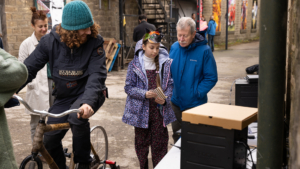
The participants aged 18-65 in the first phase were eager to engage young people in the second phase and co-devised a week on digital skills for good. The week included coding their own website for our neighbouring large scale hydro power station, Saddleworth Community Hydro, and drumming the water cycle by creating water wheels from everyday objects and nature walks.
There has been a lot of interest in the knowledge we have been gathering and logging on the project’s website. We have shared our learning through local and regional press and given tours and engaged people through regular open days and celebration events. It has shaped our venue’s 3rd birthday party; Carnival Flow, where we celebrated the power of water and its spirit, and devised interactive and Carnival elements for all ages.
Our relationships with our funders are also mutually beneficial. Data from our energy tracking and front end web development dashboard has been shared with our funders to help them to articulate their impact to stakeholders and we have supported them to engage with their focus demographics in creative and accessible ways.
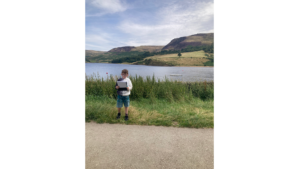
Centring the Needs of our Community
Indices of Deprivation (IMD) 2019 score places Tameside in the most deprived 10% in the UK. And this is not improving. The introduction of our hydro generator is likely to enable the entire Live Music Programme at our venue to become 100% hydro powered. This has a significant impact on our overhead costs helping to make access to high quality arts programming available to local audiences at an accessible price point. This allows us to reduce, or in some cases fully subsidise, ticket costs to enable local people to enjoy high quality arts and culture on their doorstep. It addresses the financial and geographical barriers our constituency face by reducing the need to travel to the city centre to access cultural opportunities.
We know how important this is to our communities. Participants in this project highlighted the climate crisis as a key issue for them and they want to take action into their own hands. Physically creating the turbine through action research allowed them to feel positive about the future, and see that things can change.
And this is just one step. Alongside our hydro generator we have developed a whole site approach to sustainability. This includes the introduction of solar power generation, sophisticated self designed and bespoke energy usage tracking, onsite artists accommodation and a commitment to procure locally produced resources. Together we believe that this can achieve up to 100% carbon neutrality thus creating a truly accessible cultural offer across all of our programmes and spaces.
We create the environment for Carnival and outdoor arts to bloom in a location that has little cultural infrastructure. This lack of infrastructure, although a huge challenge, gives us a blank canvas to introduce dialogue and start to create our own resources and environment from scratch. Our unique location at the foot of the Pennines also brings new opportunities that may not be available in other more urban locations.
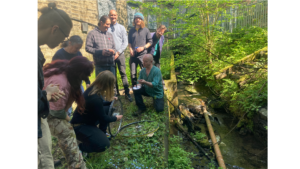
Artist Commission
We included an artist commission in our bid for the 2nd phase of the Community Knowledge Fund as we wanted to ensure the project was reflected prominently through art. It is important to share how much energy is generated digitally via a website, but we felt we’d capture a different audience by also including an on site artist commission. Responding to the environment and the community that devised it was a key requirement for the chosen artist.
Mel Roberts has a background in three dimensional design, specialising in ceramics. She has worked with found and reused objects so the artwork is in keeping with the sustainable purpose of the project. Having a chance to respond creatively to the site and project has given Mel a chance to explore the intersection between art, sustainability, and nature.
“I would like people to enjoy the space and colour rhythms in the landscape. I hope people will notice the connection to the land through the use of thrown clay, and the movement of the stream through the pattern of glazed ceramic spirals which also echo the Turbine’s impeller.”
The commission has also inspired the techniques and ways of working as Mel creates;
“I have been very conscious of sustainability and reusing or repurposing materials. For example, I used half-empty cans of butane that were unusable for their original purpose (making a fire-breathing dragon puppet breathe fire!) to scorch reclaimed scaffolding boards. Called Shou Sugi Ban, an ancient Japanese technique that needs no chemicals.”
We believe that community relevance and artistic vibrancy is the fuel of sustainability for any community arts project or organisation. The Vale and Global Grooves have developed to create a new community including artists, young people, participators, consumers, funders and stakeholders that make up our constituency.
Sustainable Practices and Community Engagement
Ideas, imagination, the feeling of ownership and agency over global problems, it’s not too big to tackle, and there can be joy in the learning and sharing and action taken, we don’t need to sit in fear.
“I have learnt that we can make things happen when we come together with a purpose.”
– Jayne, participant.
We hosted the inaugural net zero event for the Tameside business community and will host it again this December. We are looking into a green budget or a line in each budget to support sustainable work and travel. This project has had a snowball effect but beyond the project, by simply talking about sustainability and encouraging dialogue the agenda is moving to the front and centre of our organisation. It influences and impacts everyone who engages with the space. This is shown through a greater commitment in exploring more sustainable materials and resources, more conscientious use of power, monitoring our power generation and expenditure.
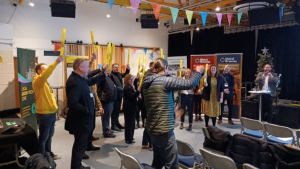
Closer to home, an energy co-op has since been established in our town, started by members of the project. This has the potential to make a huge change to local people’s lives and continue the conversation supporting other community driven projects. Our landlord has also noted the financial return renewable energy can bring and are exploring their own sustainable power generation across other sites in the Northwest.
One thing we’d do differently is apply for licences and permits much earlier. We are currently on pause before installing the turbine as we need planning permission and a licence to install it. The information available isn’t clear on this from government bodies. We were thankfully offered pro bono support from RJP Town Planners to navigate this and ensure we follow all legal requirements.
Given the challenges in the funding landscape with trusts and foundations for the arts, this project has also demonstrated that there are greater links between the arts and sustainable development more generally that we can capitalise on. Having genuine environmental projects that have high artistic vibrancy and community relevance opens up more funding streams and income generation opportunities through grant givers, trusts and foundations whilst also reducing our project overheads.
Expanding Sustainability Efforts
For the Global Grooves team, the Hydro Project has developed sustainability work at The Vale into part of the fabric and now feels firmly embedded within the team. We now have an ‘environmental impact’ project evaluation line for every commission and funded project we undertake. The next step is to further examine our Carnival makes and large scale creations to review our environmental impact and ways we can reduce it.
We are exploring micro wind power, as we’d love to have three renewable energy elements together on one site. And our gardening group is developing an irrigation system to harvest rainwater.
An outcome of this project has been The Vale’s position as a sustainable venue within Tameside and Greater Manchester. We have been invited to GM’s Green Economy Sustainability Champion network and to join the strategy board of GMAST (Greater Manchester Sustainability Team). We are working with Green Economy, part of The Growth Company to explore further building developments. We are excited to see what happens next.
Header image: Water Play – Global Grooves – Credit: Sam Orchard
